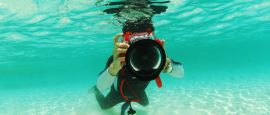Palau Weather, climate and geography
Weather & climate
Being so close to the equator, Palau enjoys a steady warm climate all year round with an annual average temperature of 30°C (86°F). Dry season runs from November to April with maximum temperatures of around 32°C (90°F) and lows of 27°C (81°F). Humidity is high all year round.
Rainy season falls between July and October, and thunderstorms are quite common but typhoons, when it can rain for days at a time, are fairly rare, as the islands are too close to the equator to be in the hurricane corridor.
For divers, the best time to go to Palau is during the dry season, from September to May, when calmer seas mean it’s easier for boats to get to particular areas. Manta rays can be seen all year round, but to see the sharks you’ll need to visit in March.
Palau’s temperate climate means that for the majority of trips, not much more than lightweight cottons, linens and beachwear will be needed. Keep a jumper on you for the evenings and if you’re venturing inland. If you’re planning to do some outdoor activities – hiking, kayaking, etc – then be sure to take the specialist equipment that you’ll need. Rain is possible all year round so don’t go without packing some sort of light rainwear – a good quality waterproof jacket may be sufficient.
Geography
The stunning islands of Palau lie 1,000km (600 miles) east of the Philippines in the middle of the Pacific Ocean. Strung out like emeralds in a necklace, the archipelago stretches over 650km (400 miles) from the atoll of Kayangel in the north to the islet of Tobi in the south. The eight main islands which are inhabited make up the bulk of Palau, but the archipelago includes more than 200 islands, and it is part of the larger Caroline Islands chain which also includes the Federated States of Micronesia.
With three exceptions, all of the islands are located within a single barrier reef and represent two geological formations. The largest are volcanic and rugged with interior jungle and large areas of grassed terraces. The Rock Islands, now known as the Floating Garden Islands, are of limestone formation, while Kayangel, at the northernmost tip, is a classic coral atoll.
Do you have any Feedback about this page?
© 2025 Columbus Travel Media Ltd. All rights reserved. No part of this site may be reproduced without our written permission, click here for information on Columbus Content Solutions.




 You know where
You know where